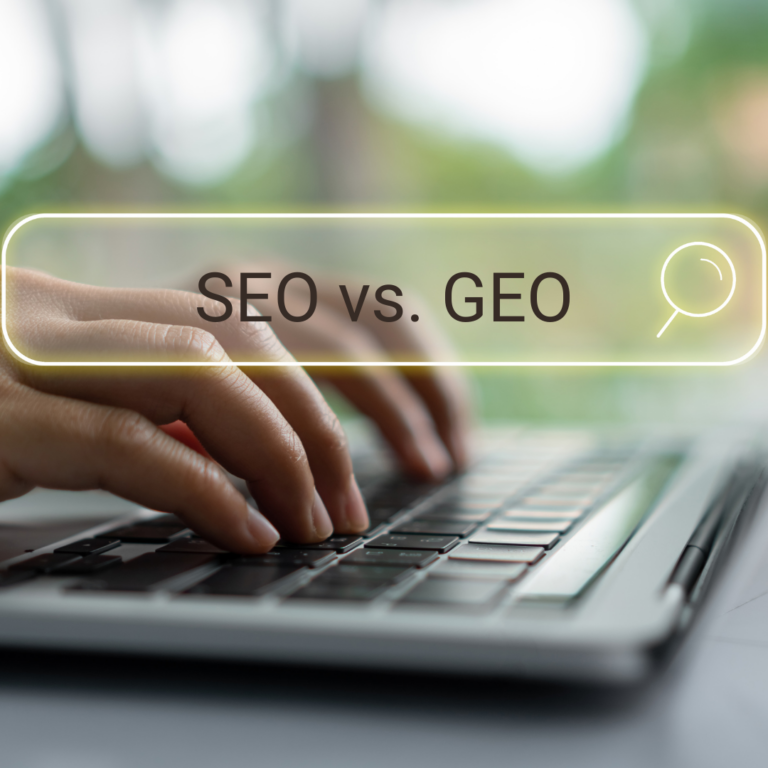Understanding the evolving landscape of digital search is crucial for businesses aiming to capture the attention of both traditional search engines and the next wave of AI-driven platforms. This article reviews the differences and synergies of SEO vs. GEO; Search Engine Optimization (SEO) and Generative Engine Optimization (GEO), guiding you through the essentials of making your content discoverable by large language models that are becoming the new search engines of the future.
SEO is about optimizing content for traditional search engines like Google Search to enhance visibility and engagement, while GEO focuses on aligning content with the preferences of Large Language Models, like Chatpgt-4, Gemini, and Claude ensuring it is readily recommended and accessible to users seeking information.
Key Takeaways
- Understanding the evolving digital landscape: SEO and GEO are essential strategies for businesses aiming to navigate the complexities of modern search technologies.
- Integration of SEO vs. GEO: Businesses must align their content strategies with both traditional search engine algorithms and the preferences of AI-driven platforms like ChatGPT-4, Gemini, and Claude.
- Forward-thinking approach: Anticipating future trends in search engine and AI technology is crucial for crafting effective SEO and GEO strategies.
- Adaptation and experimentation: Businesses should remain agile, continuously adapting and experimenting with GEO strategies as they evolve to stay ahead of the curve.
- Optimizing for the future: By optimizing for both traditional SEO and emerging GEO principles, businesses can future-proof their digital presence and maximize visibility and engagement across all search platforms.
As we delve deeper into this topic, you’ll gain valuable insights into optimizing your content not just for search engines but for the future of search itself, where AI plays a central role in content discovery and recommendation.
The Evolution of Search: From SEO to GEO
The digital marketing landscape has undergone profound changes over the past few decades, significantly influenced by technological advancements and shifts in user behavior. At the heart of this evolution has been Search Engine Optimization (SEO), a cornerstone strategy that has enabled businesses to enhance their online visibility and engage effectively with their audience. SEO has traditionally focused on optimizing content to meet the specific criteria set by search engines, such as Google, using keywords, backlinks, and website architecture to improve search rankings and user experience.
However, the advent of Artificial Intelligence (AI) and machine learning technologies has heralded a new era in content optimization, giving rise to Generative Engine Optimization (GEO). SEO vs. GEO: Unlike SEO, which primarily targets human-crafted search engine algorithms, GEO is designed to align with the preferences of AI-driven platforms, including the latest generation of Large Language Models (LLMs) such as ChatGPT-4, Gemini, and Claude. These AI models are reshaping the way content is discovered, prioritized, and presented to users, making it imperative for businesses to adapt their content strategies accordingly.
At its core, GEO extends the principles of traditional SEO to cater to the nuanced demands of AI technologies. This means not only optimizing for keywords and user experience but also ensuring that content is structured, presented, and enriched in ways that resonate with AI’s understanding and criteria for quality and relevance.
A high-level introduction to GEO’s current best practices includes:
- Emphasizing Authority and Expertise: Content must not only be accurate and fact-dense but also demonstrate authority on the subject matter through well-researched statistics, credible citations, and in-depth analysis.
- Optimizing for Natural Language and User Intent: Adopting a conversational tone, structuring content around user queries, and using varied keyword synonyms can make content more accessible and relevant to both AI models and human readers.
- Focusing on Structure and Readability: Well-organized content with clear headings, short paragraphs, and scannable lists enhances readability and navigability, making it more favorable to LLMs.
- Addressing Technical Considerations: A well-structured website, relevant metadata, and the use of Schema markup help AI understand and index content more effectively.
- Enhancing Content with Visuals and Rich Media: Incorporating images, infographics, and videos can enrich the content experience, potentially making it more attractive to AI-driven platforms that prioritize multimedia elements.
Understanding SEO vs. GEO: Key Differences and Synergies
SEO vs. GEO lies not just in their target platforms but also in their approach to content optimization. Traditional SEO has been primarily concerned with keywords, and website architecture to boost rankings in traditional search engines. On the other hand, GEO is about making content more accessible and preferable to AI systems like ChatGPT-4, Gemini, and Claude, which are increasingly being used to parse and recommend content to users.
However, the two are not mutually exclusive. The synergies between SEO vs. GEO can be harnessed to create a comprehensive content strategy that caters to both traditional search engines and AI-driven platforms. For example, keyword optimization remains necessary in GEO as it helps AI understand the context and relevance of the content.
Exploring GEO: Early Strategies for Content Optimization
LLMs are at the core of GEO, driving the AI’s ability to understand, interpret, and recommend content. SEO vs. GEO: ChatGPT-4, Gemini, and Claude represent some of the most advanced models, each with unique capabilities in processing natural language, understanding context, and generating human-like responses. Familiarizing yourself with the functioning and capabilities of these models can offer insights into how to structure and present content in a way that aligns with their processing mechanisms.
Aligning Content with GEO Guidelines
GEO optimization revolves around making content more accessible and understandable to LLMs, ensuring it’s recognized as valuable and relevant. Early strategies for achieving this include:
- Enhancing Content Authority and Expertise: Ensure your content is authoritative, with accurate, well-researched information. Incorporate data, statistics, and references from credible sources to build trust and signal quality to LLMs.
- Optimizing for Natural Language and User Intent: Write in a clear, conversational tone that mirrors human dialogue. Structure content around common user queries and incorporate a variety of relevant keywords and their synonyms to match diverse search intents. Think long, 9-plus words, keyword phrases that incorporate traditional short keyword phrases.
- Improving Structure and Readability: Use clear headings, subheadings, and short paragraphs to make content easily navigable. Bullet points and lists can help highlight key information, making it easier for LLMs to parse and understand the content. Website builders like WordPress use markdown language that LLMs can read easily. Using the built-in formatting of WordPress will go a long way in making sure your content is understood by an LLM.
- Addressing Technical SEO Elements: Ensure your website’s architecture supports easy content discovery by search engines and AI models alike. Implementing relevant metadata and Schema markup can help LLMs grasp the context and key elements of your content.
Crafting a Forward-Thinking SEO vs. GEO Strategy
Merging SEO with Generative Engine Optimization (GEO) within your digital marketing framework is necessary for keeping pace with the evolving search landscape. This dual-focused approach not only aligns with today’s best practices but also primes your business for the search technologies of tomorrow.
Aligning with Google’s Evolving SEO Guidelines
Google’s SEO guidelines are increasingly reflecting principles that pave the way for GEO compatibility. With a growing emphasis on content quality, user experience, and natural language processing, Google is subtly preparing the digital terrain for a future dominated by AI-driven search methodologies. This trend towards AI-readiness in Google’s guidelines serves as a roadmap for businesses looking to optimize for both traditional search engines and the burgeoning field of GEO. Staying abreast of these changes and aligning your content strategy accordingly can ensure sustained visibility and relevance.
Future-Proofing with SEO and GEO Integration
Adapting to the intertwining paths of SEO and GEO involves more than just following current trends; it’s about forecasting the future trajectory of search and AI technologies. The rise of voice search and AI-curated content underscores the shift towards content that’s not only information-rich but also conversationally framed, highlighting the ongoing SEO vs. GEO dynamic. Early adaptation to these evolving preferences will set a solid foundation for enduring digital marketing success
Preparing for the Future of Search and Content Discovery
As we navigate the dynamic digital landscape, the significance of both SEO and GEO becomes increasingly evident. These strategies not only shape our current online presence but also lay the groundwork for future success in the ever-evolving world of search and content discovery.
Embracing Adaptation and Experimentation
With the future of search dominated by AI-driven technologies, businesses must remain agile, continuously adapting and experimenting with GEO strategies as they evolve. This proactive approach ensures that your content remains relevant and discoverable across both traditional and emerging search platforms, effectively balancing the SEO vs. GEO landscape.
Optimizing for the Road Ahead SEO vs. GEO
By optimizing for both traditional SEO and the emerging field of GEO, businesses can future-proof their digital presence and stay ahead of the curve. This dual-focused strategy positions you to capitalize on the opportunities presented by AI-driven search technologies, ensuring sustained visibility and engagement.
Take the Next Step with Inkyma. Ready to explore the possibilities of a comprehensive SEO vs. GEO strategy for your business? Schedule a Strategy Session with Inkyma today and unlock the full potential of your digital presence.
Can SEO and GEO strategies benefit any business?
Yes, both SEO and GEO strategies can benefit businesses of all types and sizes. Whether you run a local store, an online shop, or a service-oriented company, optimizing your digital content for search engines and AI-driven platforms can improve your online visibility and attract more customers. These strategies help ensure that your business is easily found by people searching for products or services like yours, leading to increased traffic and potential sales.



























